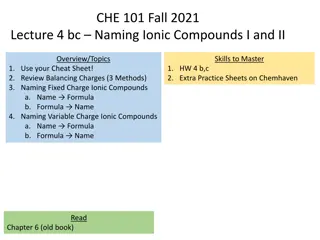
Coordination Chemistry and Complex Salts Formation
Explore the concepts of coordination chemistry, addition compounds, and complex salts through the formation of double or lattice compounds and coordination compounds. Learn about complex ions, acceptors, donors, and ligands in the realm of coordination chemistry.
Download Presentation

Please find below an Image/Link to download the presentation.
The content on the website is provided AS IS for your information and personal use only. It may not be sold, licensed, or shared on other websites without obtaining consent from the author. If you encounter any issues during the download, it is possible that the publisher has removed the file from their server.
You are allowed to download the files provided on this website for personal or commercial use, subject to the condition that they are used lawfully. All files are the property of their respective owners.
The content on the website is provided AS IS for your information and personal use only. It may not be sold, licensed, or shared on other websites without obtaining consent from the author.
E N D
Presentation Transcript
Coordination Chemistry By Mrs.A.Mumthaj, M.Sc.,M.Phil., Assistant Professsor of Cemistry, HKRH College, Uthamapalayam.
Addition or molecular compounds When solutions containing two or more simple salts in molecular proportions are allowed to evaporate, crystals of new compounds called addition or molecular compounds are obtained. These compounds are of two types: i) ii) Complex salts or Coordination compounds Double or Lattice compounds
Double or Lattice compounds These are addition compounds which exist only in crystalline state but break down into their constituents when dissolved in water. It means that the properties of double salts are essentially the same as those of the individual compounds. Examples : Mohr s salt : FeSO4.(NH4)2SO4.6H2O Potash alum : K2SO4.Al2 (SO4 )3.24H2O
Complex salts or Coordination compounds Addition or molecular compounds which retain their identity even in solution and the properties of which are completely different from those of their constituents are called complex salts or coordination compounds. Examples: When ferrous sulphate solution is mixed with potassium cyanide solution, potassium ferrocyanide is formed.
FeSO4 + 2KCN Fe(CN)2 + K2SO4 Fe(CN)2 + 4KCN K4 [Fe(CN)6] K4 [Fe(CN)6] ionises in water to give K+ ions and a complex ferrocyanide ion. K4 [Fe(CN)6] 4K+ + [Fe(CN)6]4- The complex ion has different properties from those of the ions ( Fe2+, SO42-, CN-) furnished by the constituent compounds.
Basis concepts in coordination chemistry Complex ions: A complex ion may be defined as an electrically charged radical which is formed by the union of a simple cation with one or more neutral molecule or simple ions. The complex ions have two constituents: i) An acceptor : 1. The species which accepts pairs of electrons is known as acceptor. 2. This is usually a metal ion or metal atom. 3. It is also known as central metal ion or atom 4. It acts as a Lewis acid.
ii) A donor: 1.A atom, molecule or ion which can donate one or more lone pairs of electrons is called donor. 2.It is also known as ligand. Ligands are electron rich species ( Lewis bases ) e.g. H2O, CN-, NH3, Cl-, Br-, I-, NO, CO etc. In a complex ion,the ligands are connected to the central metal atom or ion through coordinate bonds
Ligands: 1.An ion or a neutral molecule which is capable of donating a pair of electrons to the central metal atom or ion forming a coordinate bond is called a ligand. 2. In a ligand, the atom that actually donates the electron pair is known as the donor atom. Classification of ligands: Depending upon the number of donor atoms present,ligands are classified as follows. i) Monodentate ligands: H-, OH-, F-, Cl-, CN-, NO2-, NH3, H2O, CO, NO, Py (pyridine) etc. ii) Bidentate ligands: CO32-, C2O42-, S2O32-, SO3 2-, SO42- en (ethylene diamine), dmg (dimethyl glyoxime) etc. iii) Tridentate ligands: dien (diethylene triamine), terpy (terpyridyl) iv) Tetradentate ligands: trien ( triethylenetetramine) v) Pentadentate ligands: Tetraen (tetraethylene pentamine)
vi) Hexadentate ligands: EDTA (ethylene diamine tetra acetic acid) Ambidentate ligands: There are some ligands which have two or more donor atoms, but in forming complexes they use only one donor atom to coordinate the central metal ion. Examples: i) ONO- - O ii) CN- -C NC- -N NO2- - N Coordination number: It may be defined as the maximum number of groups (ligands) which can be coordinated to the central metal atom or ion. Eg. K4[Fe(CN)6], six CN- ligands are coordinated to the central Fe2+ ion and hence the Coordination number of Fe2+ is 6.
Oxidation number: It may be defined as the number of units of charge that an atom seems to possess in a molecule or ion. Eg. The oxidation number of Fe in [Fe(CN)6]4- is +2.
Nomenclature of Coordination compounds : 1. Order of naming coordination compounds : As in simple salts, the cation is named first followed by the anion. The names are separated by a space. Examples : [Co(NH3)6]Cl3 - Hexamminecobalt(III) chloride K3[Fe(CN)6] - Potassiumhexacyanoferrate(III) However, neutral complexes are given one word names without any break 2. Naming of complex ions : The complex ion is named in the order : i) ligands ii) central metal ion followed by a Roman numeral in bracket to indicate its oxidation state. In complex anions, the suffix ate is attached to the name of the central metal atom or ion. In the case of complex cations and neutral complexes, The name of the metal is used as such.
Examples : [Co(NH3)6]3+ - Hexamminecobalt(III) ion. [Fe(CN)6]3- - Hexacyanoferrate(III) ion [Pt(NH3)2 Cl4 - Tetrachlorodiammineplatinum(IV) 3. Naming of ligands : i) Neutral ligands : These are named as the molecules. However, special names are given to more common neutral ligands. Examples : H2O - aqua NH3 - ammine CO - carbonyl CS - thiocarbonyl NO - nitrosyl NS - thionitrosyl
ii) Negative ligands : Examples : H- NO2- nitro (-N) ONO- nitrito (-O) NO3- nitrato SO32- sulphito SO42- sulphato CH3COO- acetato NH2- amino NHOH- hydroxylamido hydrido C2O42- oxalato SCN- thiocyanato (-S) NCS- isothiocyanato (-N) F- fluoro Cl- chloro Br- bromo OH- hydroxo O2- oxo CN- cyano
4. Number of ligands : The number of simple ligands like Cl-, CN-, C2O42- etc is indicated by the prefixes di, tri, tetra, penta, hexa etc. In the case of complicated ligands like ethylenediammine, dipyridyl etc which have already the prefixes di, tri etc in their names, the prefixes Bis, tris, tetrakis, pentakis, hexakis etc are used. Examples : [Co(NH3)6]Cl3 Hexamminecobalt(III) chloride [Co(en)3]Cl3 Tris(ethylenediammine)cobalt(III) chloride
5. Order of naming ligands : If the complex contains more than one type of ligand, the ligands are named in the alphabetical order, regardless of their charge. 6. Naming of polynuclear complexes : The complexes having two or more metal atoms or ions are called polynuclear complexes or bridged complexes. In these complexes, the bridging group is indicated by adding the Greek letter .
Examples : [Co(NH3)6Cl3 Hexamminecobalt(III)chloride [Cu(H2O)4]SO4 Tetraquacopper(II) sulphate [Zn(NCS)4]2+ Tetraisothiocyanato-N zinc(II)ion [Cd(SCN)4]2+ Tetrathiocyanato-S cadmium(III)ion [CoCl2(en)2]SO4 Dichlorobis(ethylenediammine)cobalt(III)sulphate K3[Fe(CN)6] Pottasiumhexacyanoferrate(III) K3[Fe(CN)5NO] Potassiumpentacyanonitrosylferrate(II) Fe(CO)5 Pentacarbonyliron(0) [(NH3)5Cr-OH-Cr(NH3)5]Cl5 -hydraxodecamminedichromium(III)chloride
Reference : 1. Modern Inorganic Chemistry R.D.Madan (Revised Edition,S,Chand,2013).






















